
Although every aspect of higher education has become digitized, that doesn’t mean that personal connections are less important in the admissions process. In fact, meaningful conversations are even more critical in a time when social interaction largely takes place online.
Trust, confidence, and communication between prospects and schools will always be important, regardless of whether the courses are online or not. Traditionally, campus tours, one-on-one meetings, and in-person events have created these personal connections – but fortunately for schools, it is possible to replicate these experiences online. All you need is a solid strategy and the right tools.

Host Virtual Events to Market Online Education
For many schools, recruitment events play a crucial role in the admissions process. After all, you’ve got the undivided attention of highly interested prospective students for hours at a time. How have these schools dealt with the cancellation of campus tours, recruitment fairs, and open houses?
The answer: virtual recruitment events. From webinars to livestreams, there are many ways to host events in real time online, as well as record them for future prospects.
Example: The Webinar Centre on Algonquin College’s site. The college records every webinar it hosts, and conveniently stores them in one place, so prospects can learn about an area of study or aspect of the school with ease.

It’s important to make sure you’re targeting prospects at every stage of the enrollment process with your events, so don’t neglect those who have been accepted, but haven’t yet started their studies.
Many prospective students apply to more than one school, so it’s important to provide them with as many resources as possible that show why they should choose yours.
Example: Webinar for admitted students from Linkoping University.

The above examples showcase pre-recorded webinars that prospective students can access and watch at any given time, making them eminently convenient for those scrolling through your site.
In conjunction with these videos, your school should consider hosting live events so prospects can connect with your school in real time.
Example: An Instagram Live broadcast from EC English Language Centre featuring an instructor touring around the school.
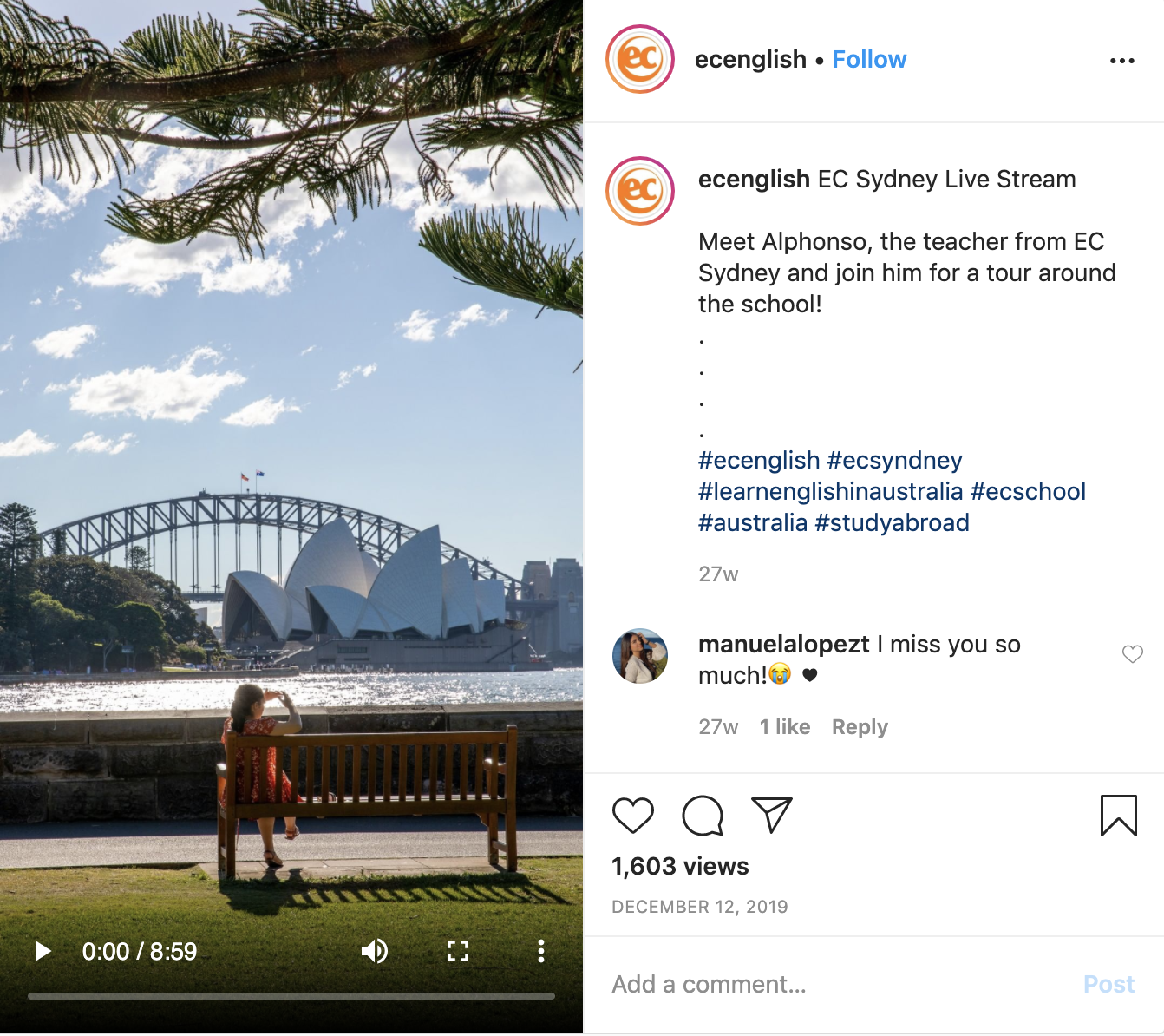
Whether you host a live webinar, or stream it on social media in real time, one of the greatest benefits of these types of online events is the ability for you to answer your prospects’ questions during them. This allows you to address common admissions concerns, while really giving the experience of attending an in-person event.
Example: A Facebook Live event from the University of Oxford, with over 75 comments.
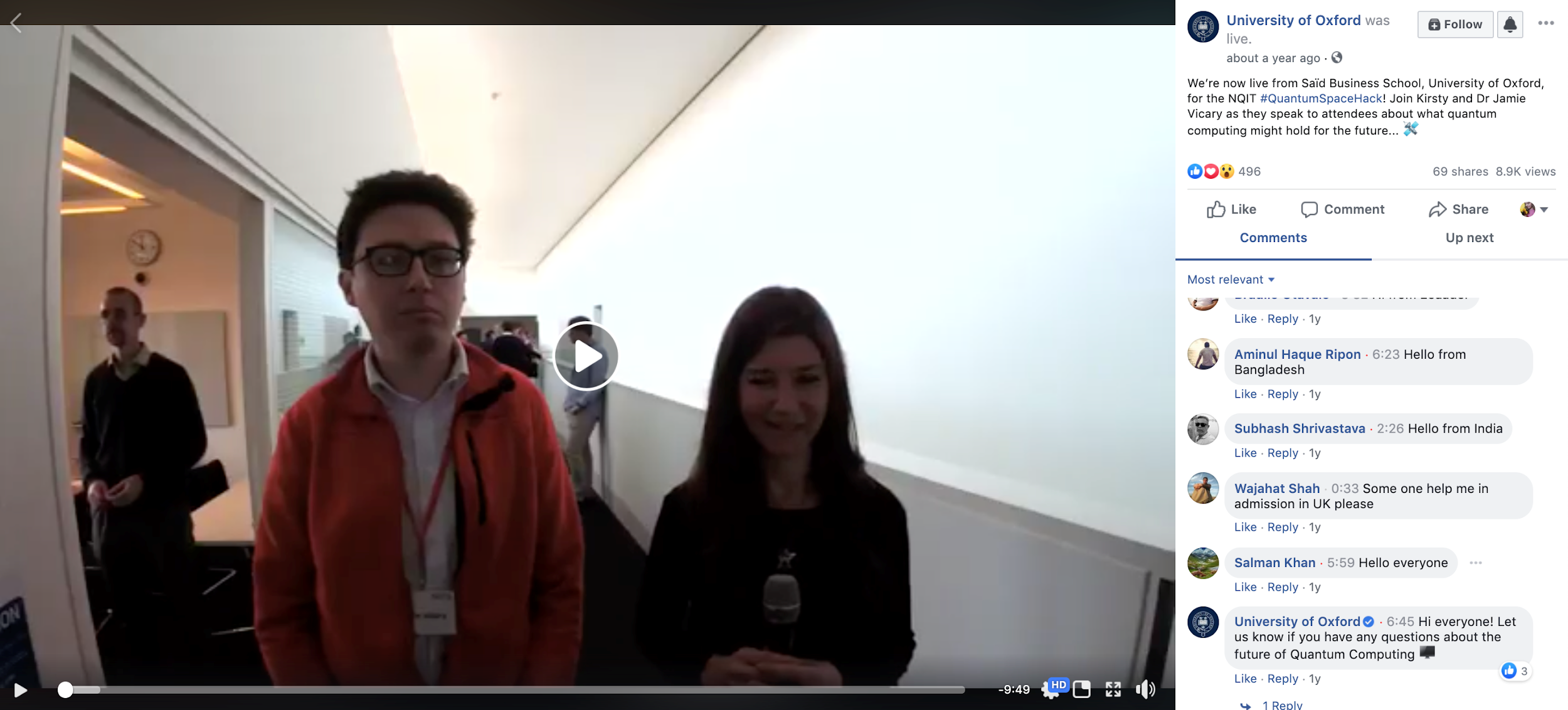
Recruitment events can help your school serve a variety of purposes. Prospects can get the look and feel of your school, receive a ton of information in a condensed format, or gain insight into a particular program or admissions area. With the right tools, your school can provide the same value in its online events.
Introduce Prospects to Your School Community to Recreate the Admissions Experience Online
Putting a face to your school can work wonders for marketing online education. If prospects can see what life is like for current students, connect with experienced faculty, or see what your school’s alumni are up to, they’ll start to feel at home before they even apply.
One way to facilitate this personal interaction remotely is to have current students or alumni ‘take over’ your social media channel for the day. This trend is especially popular on Instagram, where guest posters share a variety of Stories – touring the school, talking about their experiences, creating polls – that are deleted after 24 hours so your feed doesn’t become flooded with non-native content.
Example: An alumni Instagram takeover on the McGill Admissions Instagram page. McGill introduces the graduate in an Instagram post, and has them post Instagram Stories for the day.

You could also introduce professors, faculty, and staff through videos or live events.
Example: Acadia University’s webinar series entitled ‘Meet Your Professors’. The school has a video spotlighting the members of each department on its website.
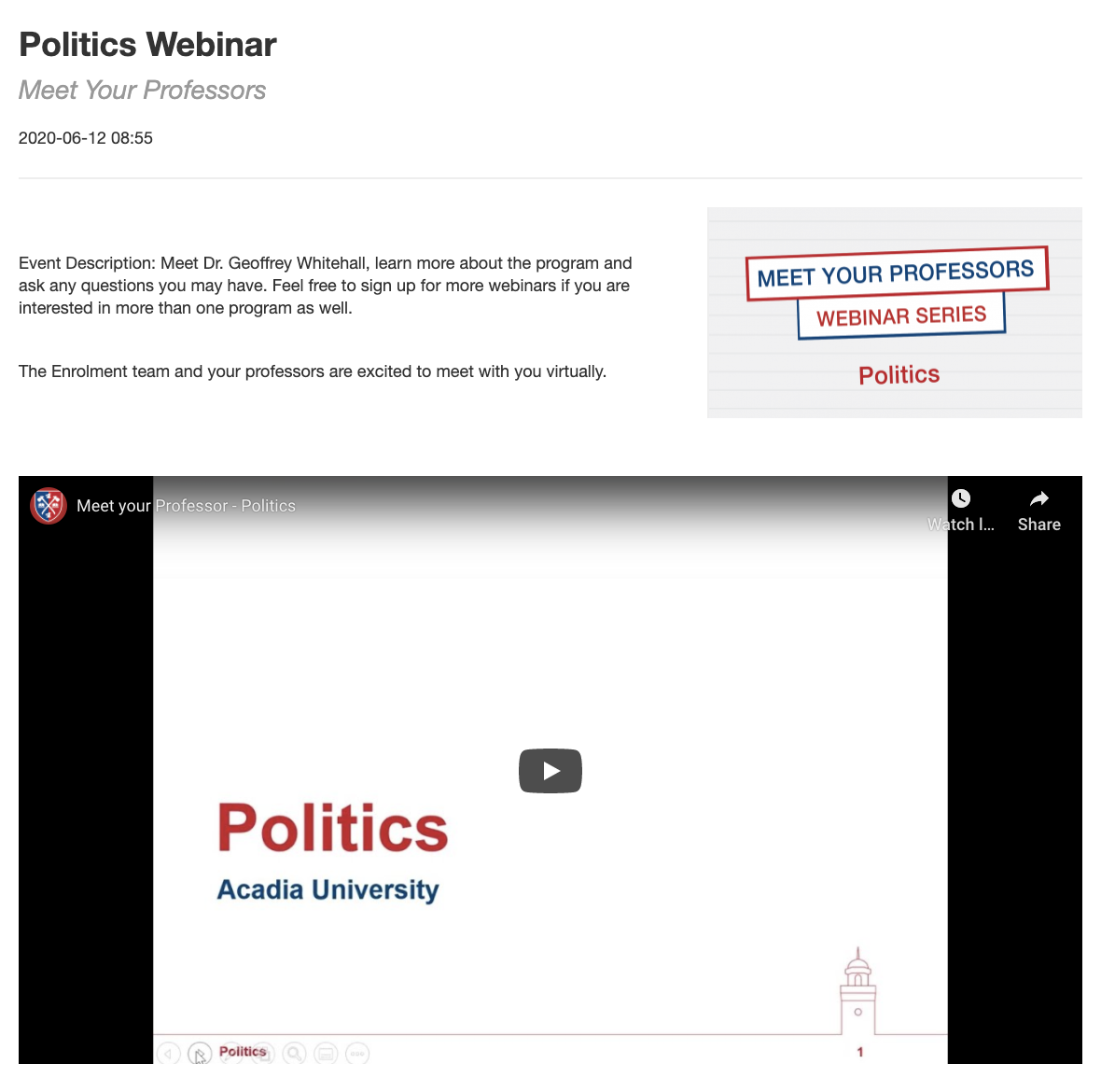
Although it’s not possible to forge personal connections in person, you can still convey the same information and emotions online. What’s more, through these videos, webinars, and other tactics, you can connect even more prospective students.
Improving Manual Follow-up Using CRM and Marketing Automation for Schools
For many schools, in-person conversations with admissions counselors play an essential role in the admissions process. The obvious digital replacement for this recruitment tactic is phone calls and Skype or Zoom meetings, but what may be less obvious is how to make these tactics as effective as possible.
After all, the more individualized a recruitment tactic is, the more effective it’s likely to be – but the more time and resources it will likely require. That’s why investing in CRM and marketing automation for schools has never been more important. If you want to manually reach more prospects more efficiently, a CRM is the way to go.
HEM’s Mautic CRM is specifically designed for the education sector, so it makes student recruitment easy, organized, and optimized.
Every new lead your school generates is automatically added to Mautic so you can contact prospects as soon as they express interest in your school.
Example: Mautic’s contact database.
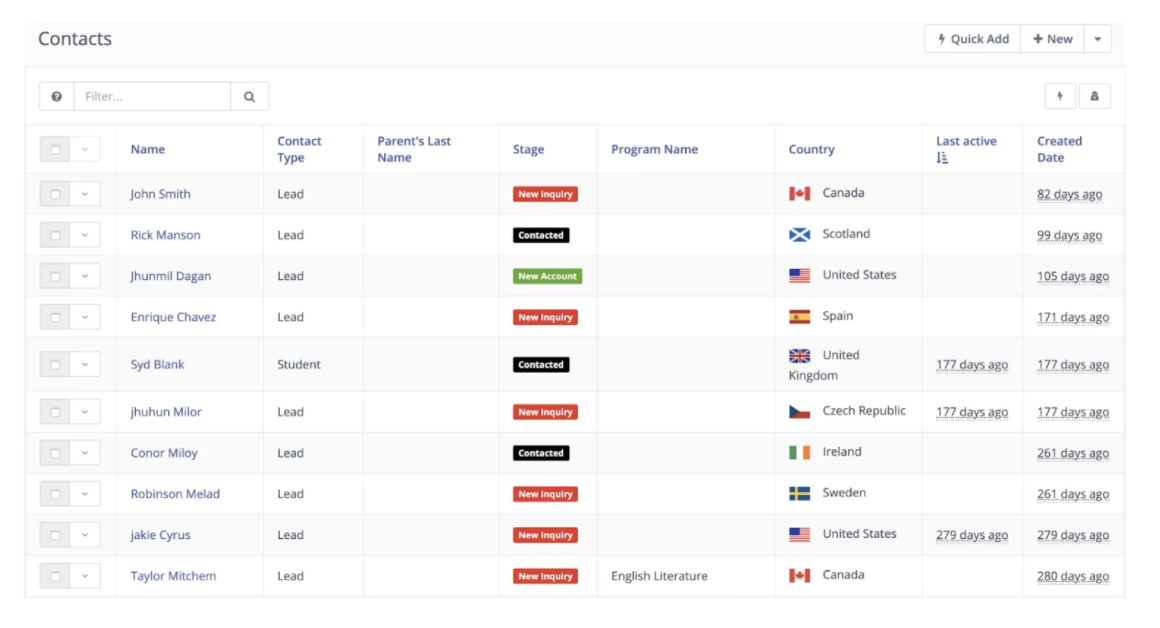
Each contact has a highly detailed profile where you can directly call, email, and text them with the click of a button. Any and all interactions with your school are automatically recorded in the contact profile. In addition, your admissions team can create notes and log calls to keep track of its follow-up activities.
Example: The ‘Call’ menu in a Mautic contact profile. As you can see, schools can set the call status and add notes.

You can also schedule additional follow-up tasks in Mautic. These activities can be integrated with Mautic’s calendar, as well as Google Calendar, so your school can manage productivity amongst your team.
Example: The calendar feature in Mautic CRM.
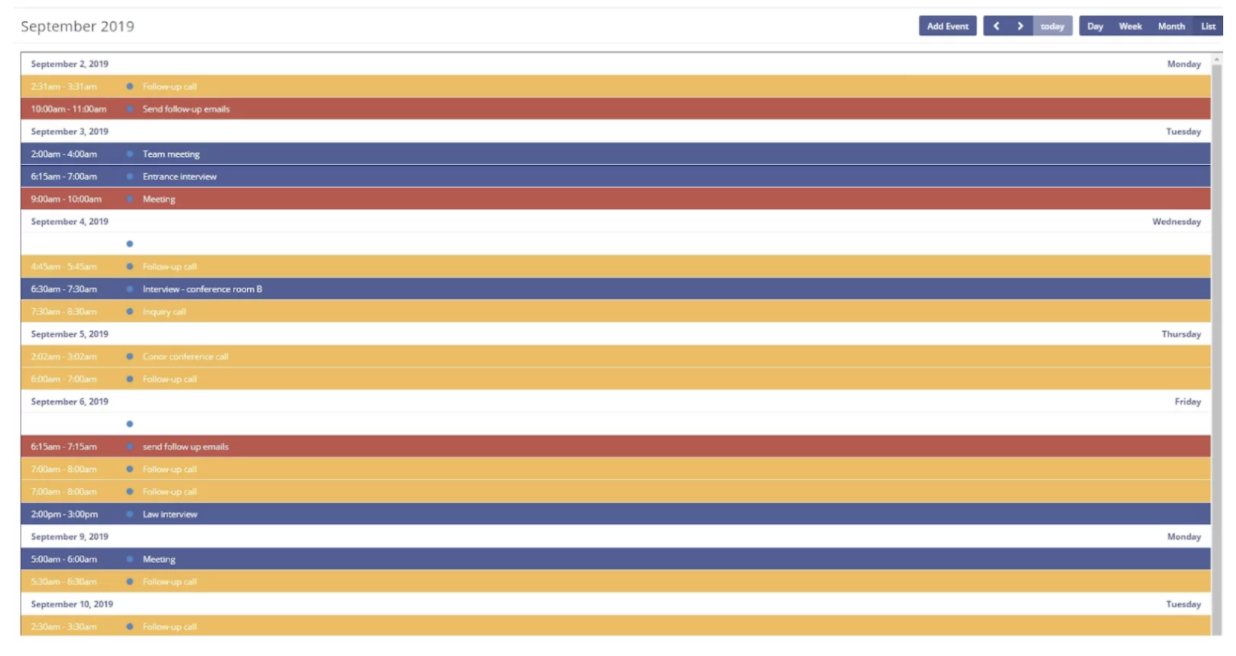
Although much of what a CRM does contributes to is ‘behind the scenes’ of the admissions process, its impacts will still be felt by prospective students. Admissions officers will remember details from phone calls and Skype sessions, making conversations not only more organized, but more meaningful.
Marketing Online Education Through Personalized Automated Follow-up
While individual conversations can have a major impact on admissions, and phone calls and Skype sessions are a highly accurate way to replicate the admissions experience online, that doesn’t mitigate the role of automated follow-up.
Yes, sometimes automated activities like email and SMS workflows can come off overly generalized, but with the right strategy, these tactics can actually contribute to the personalized admissions experience your school strives to offer.
With CRM and marketing automation software, you can tailor your follow-up based on a prospect’s program of interest, stage in the admissions process, and more.
To do so, you can start by segmenting prospects by whichever factors are relevant to your school. If you think that creating different emails for different courses or campuses is worthwhile, start there.
Example: Lead segmentation by country in Mautic CRM. Every time a lead from a certain country enters your system, they will automatically be placed in the corresponding list.
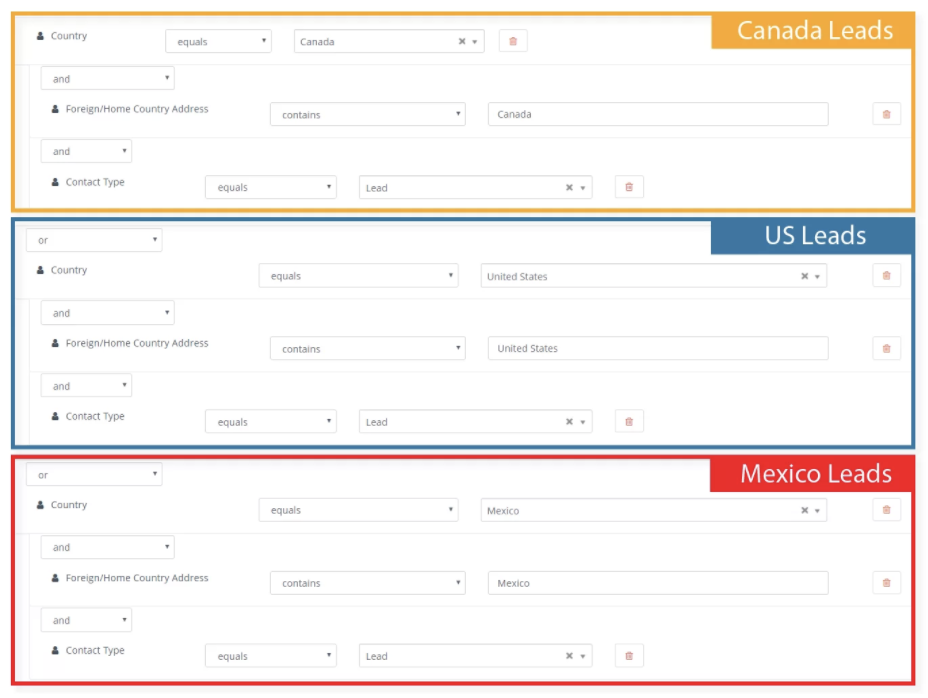
From there, you can create workflows tailored to these prospective students, with content offers relevant to their needs and concerns. This helps increase the chances that prospects will not only read, but appreciate, your emails instead of automatically flagging them as spam.
Example: An email workflow catered to leads that request information for an online intensive English program.

As for the emails themselves, you can use marketing automation software to further customize the messaging. Through dynamic content, you can automatically alter various email components like text, content offers, and CTAs based on a prospects’ niche characteristics.
One simple way to spruce up the body of your emails is to add personalization tokens. This marketing automation feature allows you to address prospects by name and mention the program they’re interested in.
Example: Two dynamic emails, a default mail and one for a particular segment, designed for business schools. Both emails contain personalization tokens that will adapt the content based on the prospect’s name, city, and program of interest. The email for New York leads also contains a personalized paragraph.

Another innovative way to personalize your emails is through smart CTAs. These calls to action adapt to your prospects and show them the message or content offer that they’re most likely to click.
Example: Smart CTAs in HubSpot that target prospects at different stages of the booking process.
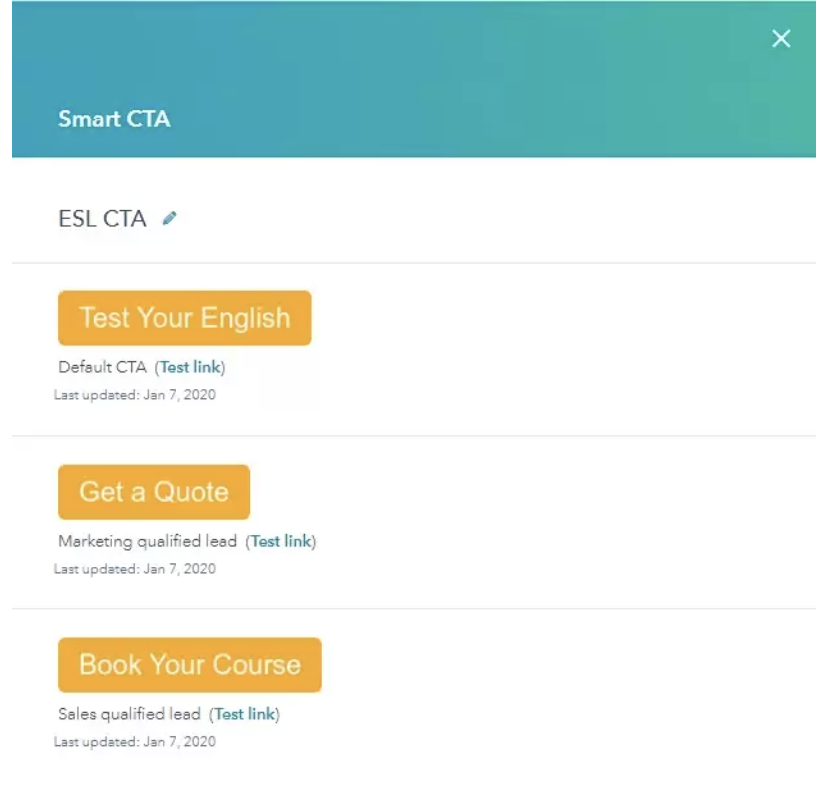
With marketing automation software, you can then monitor the impact of your individual emails and automated workflows in order to further refine your dynamic content use over time.
Example: An email ‘click map’ in HubSpot which shows which links got the most clicks.

By customizing and tailoring your automated digital marketing activities to your prospective students, you show that your school understands its audience and is pulling out all the stops to make even automated communication feel as lifelike as possible.
Invest in Admissions Software to Prepare Prospects for Their Future Studies
At this point in the blog, we’ve outlined a bunch of different ways you can help prospects learn more about your school, connect with your staff, and get the look and feel of it without having to leave their living room.
But what about those at the end of the enrollment process, who don’t need convincing that your school is great, but may need help taking that final step towards enrollment? In a perfect world, these prospects would meet up with an admissions advisor in person to crunch tuition numbers and plan out their studies.
However, with the right software, you can replicate these sessions online. HEM has created two different programs to help different school types accomplish this very purpose.
Our Virtual Admissions Assistant and Quote Builder are stepped programs that allow prospective students to plan out their studies in an informative, intuitive, and easy-to-use format. Both programs are also built into HEM’s Student Application Portal, so they serve as a great gateway to the application process.
Virtual Admissions Assistant
For many schools, a campus tour or interview is often the last step in the admissions process. Students meet with an admissions counselor in person and plan out a study plan that works with their experience and goals. Our Virtual Admissions Assistant is designed to digitize this process.
Example: A sample Virtual Admissions Assistant (VAA). Prospects can walk through each step in the application process – selecting a campus, program, and financial aid option, if applicable – and at the very end, they’re invited to apply to your school. There’s also a helper icon in the bottom left-hand corner to help guide prospects through the process.
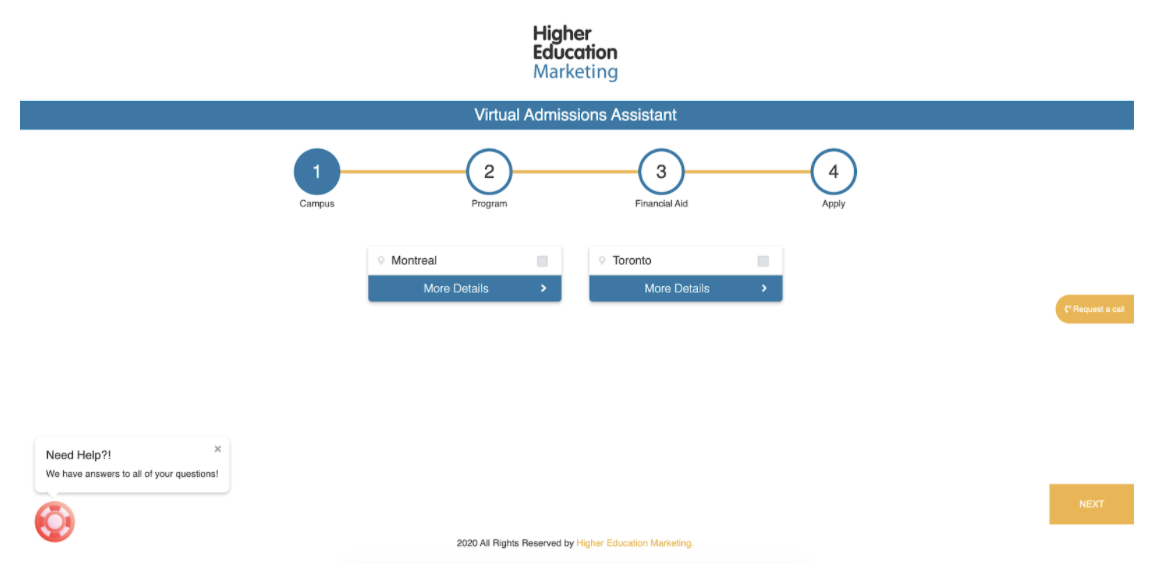
To learn more about a particular campus, program, or another aspect of their chosen study path, prospects can click ‘More Details’ to access videos, maps, images, and additional info.
Example: An individual course option in the VAA. If you offer different start dates for various programs, you can add them here.
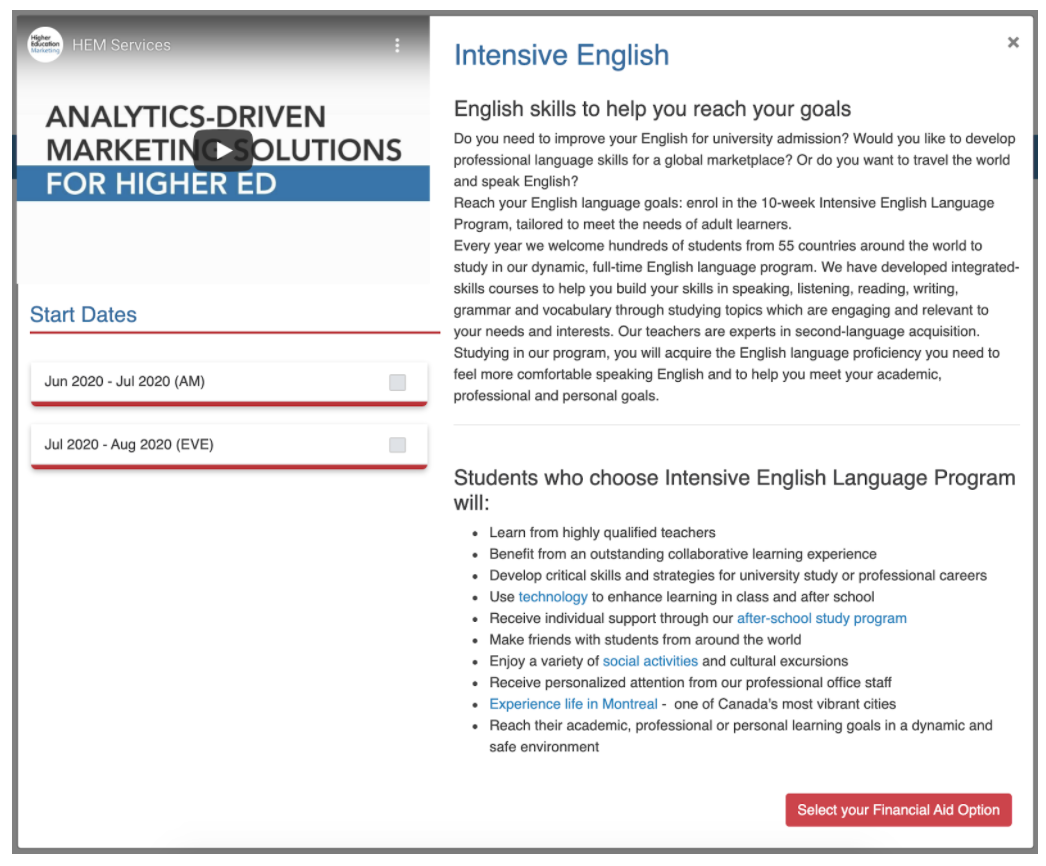
Prospective students can also get in touch with your school at any point in the process, just as they could ask a question in person.
Example: The ‘Request a Call’ form in the VAA. If you use HEM’s Student Application Portal, or integrate the VAA with Mautic CRM, your staff will be notified the moment a prospective student requests a call.
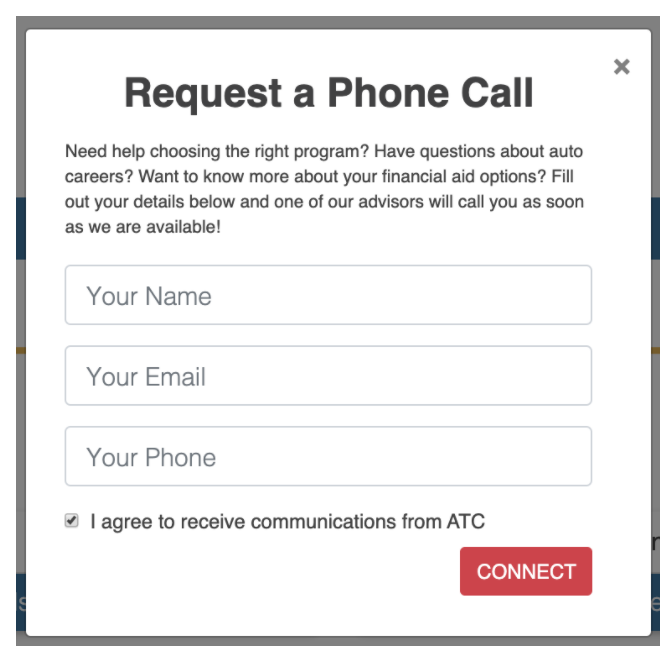
Once prospects reach the end of the VAA, they’ll receive a summary of their selection, which can be emailed to them, as well as an invitation to apply via HEM’s Portal.
Example: The final step in the VAA.

Quote Builder
Booking a course can often be a complicated process for prospects as there are usually many different components – from program selections to accommodation options – to choose from.
Our Quote Builder helps prospects explore all the different options available to them, and optimally plan out their studies, so they feel confident and prepared when they book their course.
Like the VAA, schools can customize each section of the Quote Builder and add as many different options as they need.
Example: Sample Quote Builder for a language school. You can adjust prices for high and low season.

Like the VAA, the last step of the Quote Builder provides a summary of the quotation. Prospects can have it sent to them via email, or go straight to booking.
Example: The ‘Quote’ section of HEM’s Quote Builder.
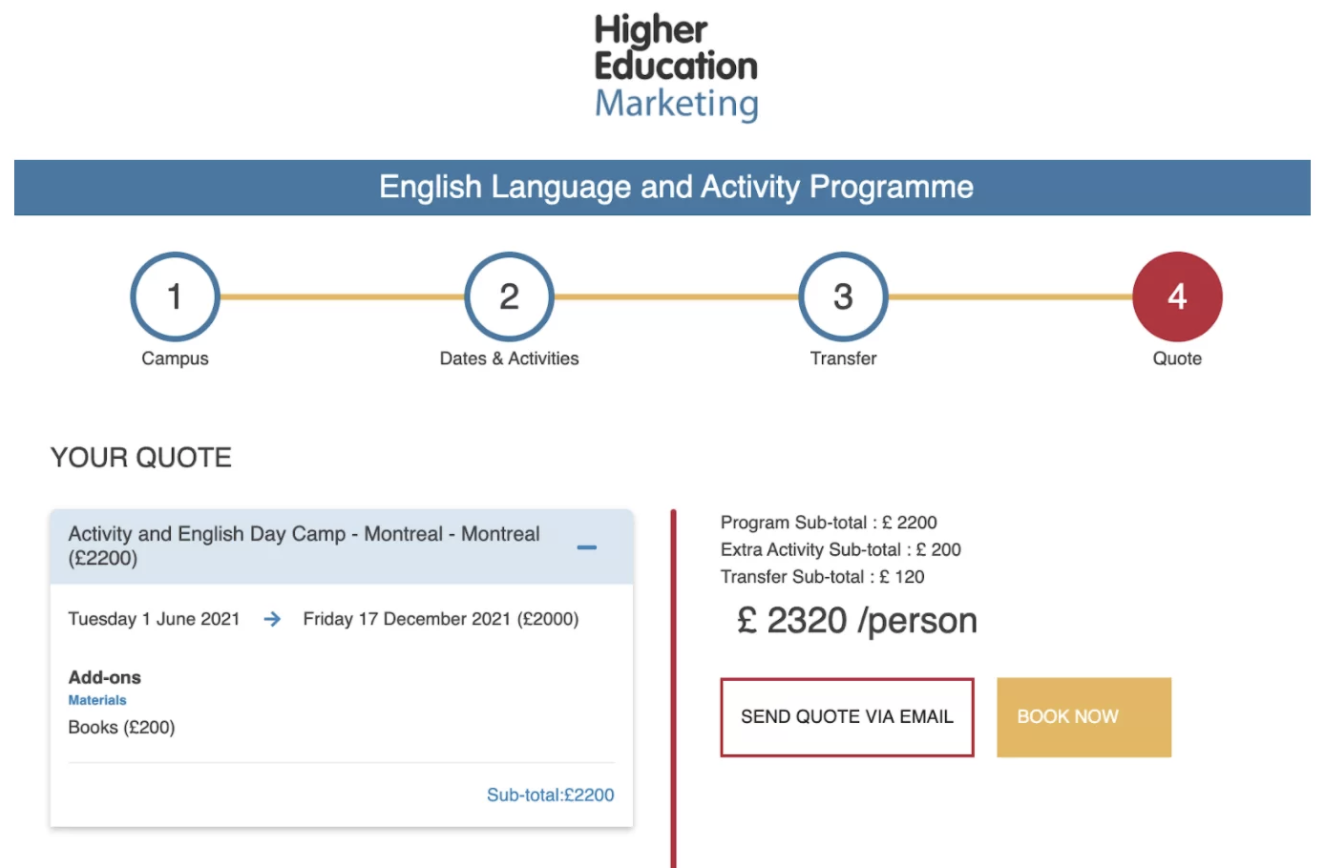
Anyone who launches the Quote Builder or VAA can be stored in HEM’s Portal or CRM for easy follow-up and monitoring.
Example: The Applicants section in HEM’s Portal. Here, you can easily see which stage each lead is at in the admissions process.
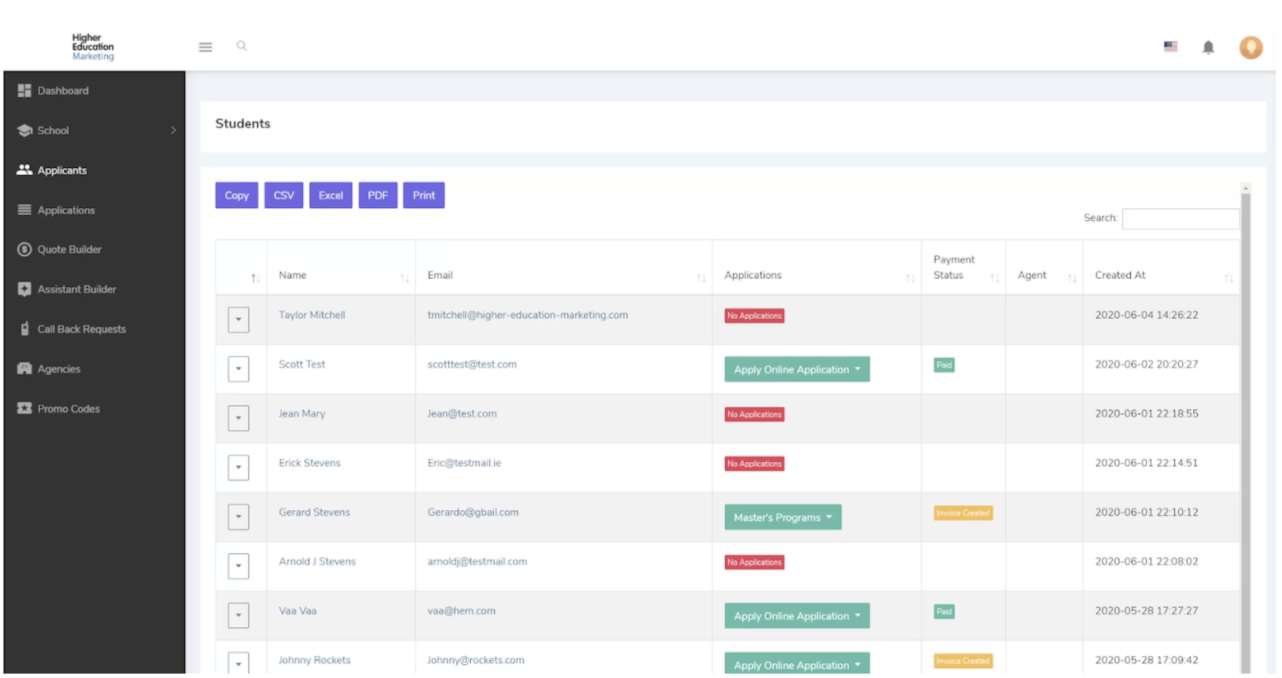
If your school wants to create a personalized online admissions experience, you should strive to help prospects develop a connection with your school online, and to provide them with the relevant and personalized information that they’d receive in the flesh.
Both the Quote Builder and the VAA help prospects walk through the admissions process as if an advisor was there to guide them through it. Providing prospective students with these kinds of resources will help them feel supported from the moment they stumble on your school’s website up until the moment they apply.






